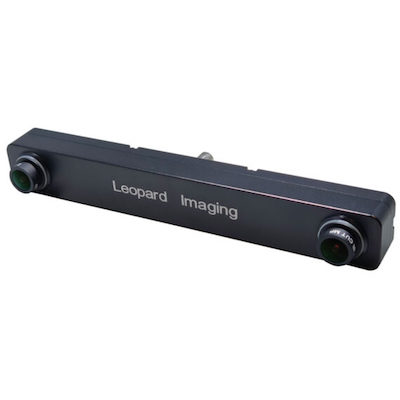|
Listen to this article  |
Leopard Imaging introduced its Hawk 3D depth camera for $349. The camera, which supports NVIDIA’s Jetson edge AI and Isaac robotics platforms, is designed to deliver real-time, accurate depth perception. The Hawk camera offers a horizontal field of view of 120 degrees, and integrates dual onsemi AR0234CS RGB image sensors with an active-pixel array of 1,920 by 1,200 pixels to support full HD video up to 120 frames per second.
Leopard Imaging said the dual RGB global shutter sensors reduce visual artifacts for improved perception performance in any high-vibration environments that a robot may encounter. This is coupled with a six-axis IMU for sub-microsecond time-stamping of the camera frames relative to the IMU.
 The Hawk camera provides depth perception from 15 cm to 5 m and has the ability to detect 10 cm by 10 cm objects. The camera works with NVIDIA’s Vision Programming Interface (VPI) algorithms and integrates to the Isaac platform to ensure performance on the Jetson AGX Xavier and Jetson Xavier NX system on modules (SOM). Out of the box, the camera is supported by the Isaac ROS GEMs, enabling developers to integrate it in their products.
The Hawk camera provides depth perception from 15 cm to 5 m and has the ability to detect 10 cm by 10 cm objects. The camera works with NVIDIA’s Vision Programming Interface (VPI) algorithms and integrates to the Isaac platform to ensure performance on the Jetson AGX Xavier and Jetson Xavier NX system on modules (SOM). Out of the box, the camera is supported by the Isaac ROS GEMs, enabling developers to integrate it in their products.
The NVIDIA Jetson platform includes pretrained AI models, developer SDKs and support for cloud-tative technologies across the full Jetson lineup, giving manufacturers of intelligent machines and AI developers the opportunity to build and deploy high-quality, software defined features on embedded and edge devices that target robotics, among other applications.
“By leveraging our full stack of GPU-accelerated computing technologies and enabling ease of deployment of cost-effective 3D camera solutions, Leopard Imaging is accelerating time-to-market of vision-based edge AI and robotics applications,” said Murali Gopalakrishna, head of product management, autonomous machines and general manager for robotics at NVIDIA.
The NVIDIA Isaac platform includes comprehensive tools, application frameworks, GPU-enabled algorithms, reference designs, and pretrained capabilities to accelerate development workflows for robotics applications. This includes Isaac Sim on NVIDIA Omniverse for simulation and training of robots in virtual environments before deploying them in the real world; and Isaac ROS open software development framework that speeds up robotics development and deployment. A suite of Isaac GEMs for ROS – pre-optimized software packages to accelerate image processing and DNN performance on NVIDIA Jetson – make it easier to add AI for perception and navigation into modern-day robots.
Credit: Source link


Comments are closed.